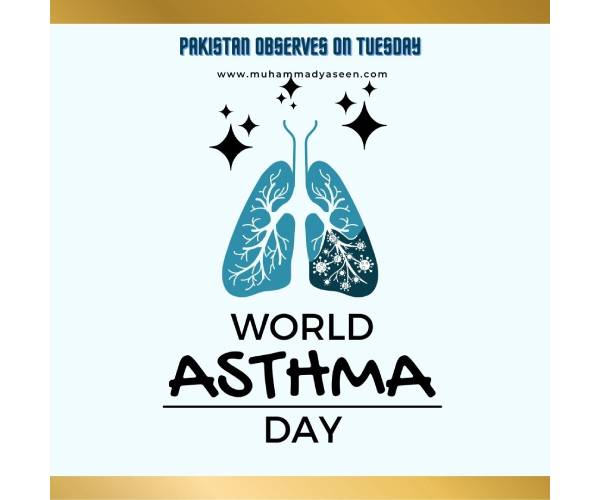World Asthma Day (7th May) observed in Pakistan in 2024
Asthma definition
A respiratory ailment characterized by bronchial spasms, leading to breathing difficulties, typically triggered by allergic reactions or heightened sensitivity.
Asthma reasons
Asthma is mainly caused by a mix of genetics and things in the environment like allergies, pollution, infections, and smoking. Some factors in childhood, such as infections and secondhand smoke, can make it more likely to develop asthma later on.
Lifestyle choices like being overweight or not being active enough can also play a role. Stress and certain medicines might make symptoms worse too. Asthma makes breathing harder, leading to wheezing, coughing, chest tightness, and trouble breathing. It’s different for everyone, but genes, surroundings, and how the immune system works all have a part to play.

Asthma types
In contemporary understanding, bronchitic syndrome transcends a singular ailment. Instead, it encompasses various classifications, such as:
- Allergic
- Aspirin-induced
- Cough-variant
- Exercise-induced
- Nocturnal asthma
- Steroid-resistant
- Occupational
Each type necessitates tailored management strategies and treatment modalities to effectively address its unique manifestations and challenges.
Asthma Symptoms
Asthma symptoms vary, but common signs include wheezing, often during exercise or illness, a persistent cough, particularly at night, shortness of breath occurring sporadically or frequently, and chest tightness, especially in cold weather or during physical activity.
Various factors can trigger these symptoms in asthma sufferers, including respiratory infections, allergens, chemicals, odors, physical exertion, emotions, seasonal changes, and smoking. Identifying personal triggers is crucial for effective management.
Collaborating with healthcare providers to pinpoint triggers enables individuals to avoid or minimize exposure, thus mitigating airway inflammation and symptoms and enhancing overall quality of life.
Asthma is a chronic lung condition that causes recurring symptoms like wheezing, shortness of breath, chest tightness, and coughing, particularly during the night or early morning. Effective management involves medication usage and avoiding triggers that can provoke breathing difficulty and condition attacks. It’s equally important to eliminate environmental factors that exacerbate the condition.
In Pakistan, World Day is observed annually, typically on the first Tuesday of May. On this day, various events and activities are organized to raise awareness about reactive airway disease and its management. These may include free screenings, educational lectures, awareness campaigns, and community walks. Healthcare professionals, organizations, and government agencies collaborate to provide resources, education, and support for individuals with asthma and their families.
Moreover, initiatives like the CDC’s National Control Program in the United States also play a significant role in improving bronchospasm disorder & management and enhancing the quality of life for affected individuals worldwide.
Asthma Attack
An asthma attack happens when asthma symptoms suddenly get worse. Asthma makes it hard to breathe because the tubes in the lungs get narrow. Signs of an asthma attack include coughing, wheezing (making a whistling sound when you breathe), chest tightness, and feeling like you can’t get enough air.
Asthma Treatment
Recognizing the best treatments for short-term relief and long-term control of this disease is crucial for managing symptoms effectively. If symptoms or breathing difficulty condition occur, knowing when to contact a healthcare provider can prevent emergencies. Treatment options include fast-acting rescue medicines, long-term treatments, or a combination of both.
Fast-acting rescue medicines, such as rescue inhalers, help ease the symptoms by relaxing the muscles around the airways, allowing for easier breathing. It’s essential to consult a doctor if these medications are used more than twice a week. Short-acting beta-agonists and anticholinergics are common choices for quick relief.
Long-term control medicines, like inhaled corticosteroids and long-acting beta-agonists, aim to prevent type of attacks by reducing airway inflammation and opening the airways. Combination medicines that include both an inhaled corticosteroid and a long-acting beta-agonist are also available for added convenience.
Biologics, leukotriene modifiers, and cromolyn are additional options for management, targeting specific aspects of the condition to reduce inflammation and swelling in the airways.
It’s essential to work closely with a healthcare provider to determine the most suitable treatment plan based on individual needs and symptoms. Regular monitoring and adjustments to the treatment regimen may be necessary to ensure optimal bronchial hypersensitivity control and overall well-being.
Bottom line
Asthma attacks are sudden worsening of symptoms in this long-term breathing condition. When airways in the lungs narrow, it becomes hard to breathe. Coughing, wheezing, chest tightness, and difficulty getting enough air are common signs.







